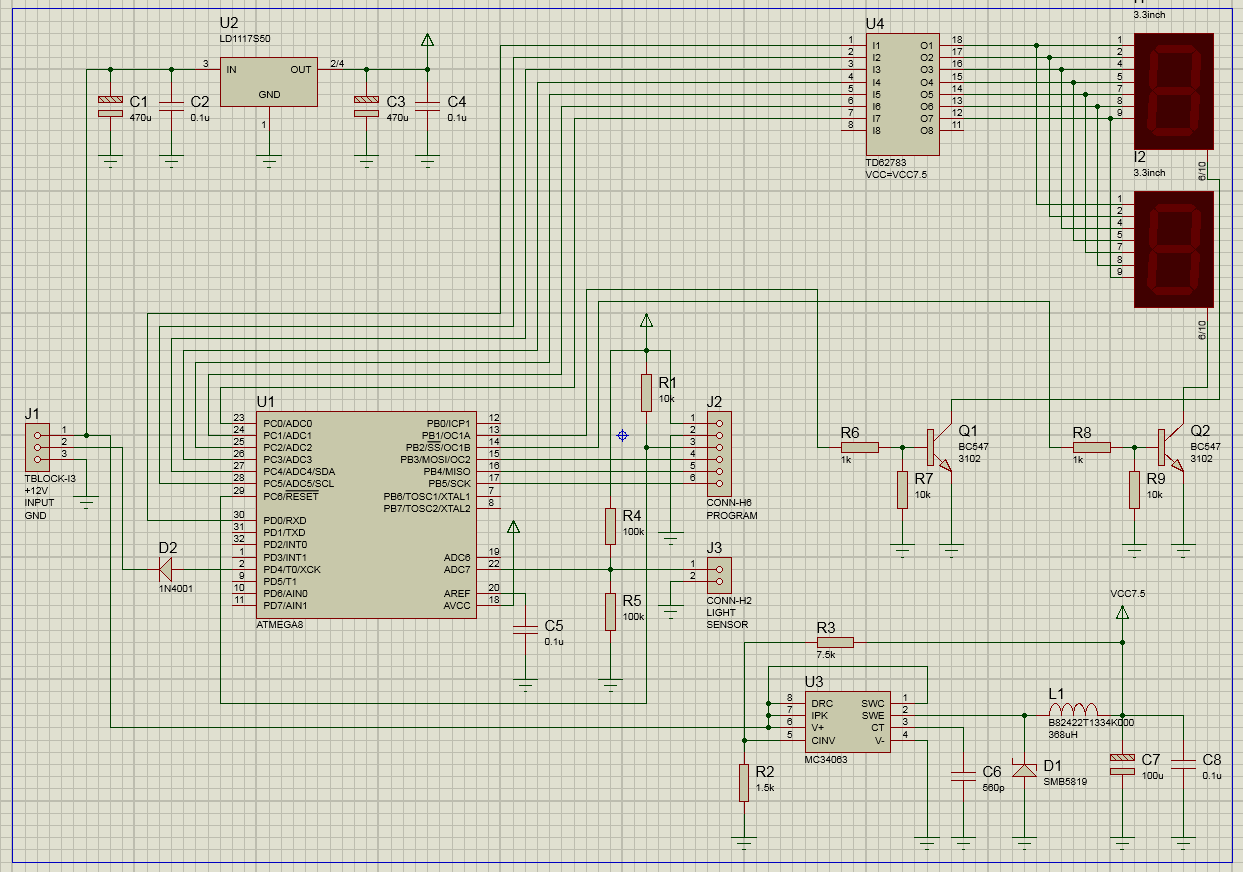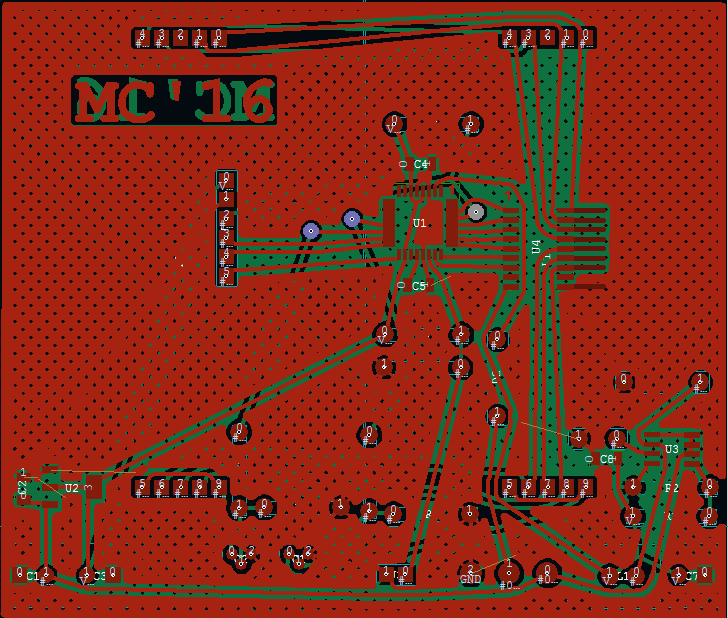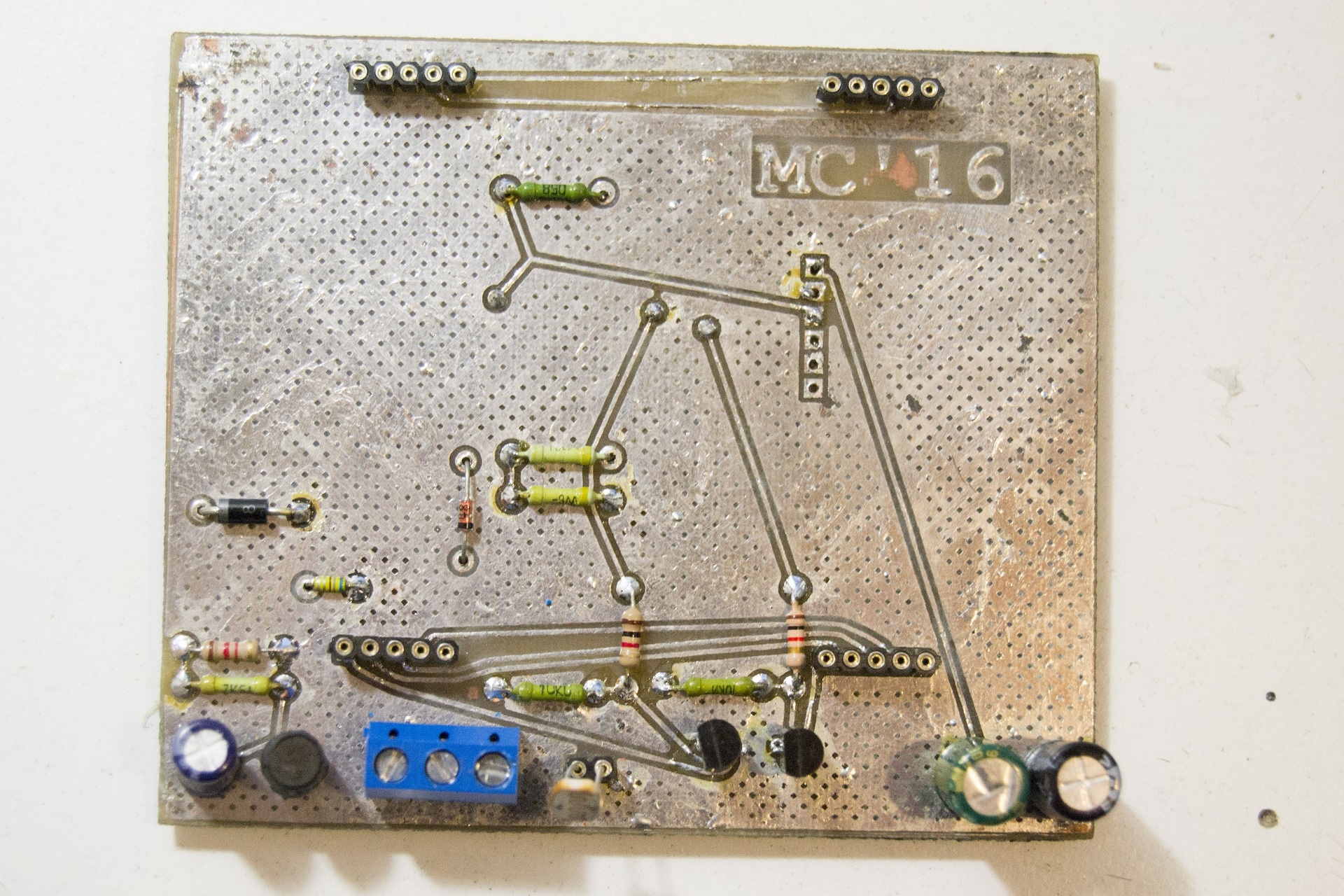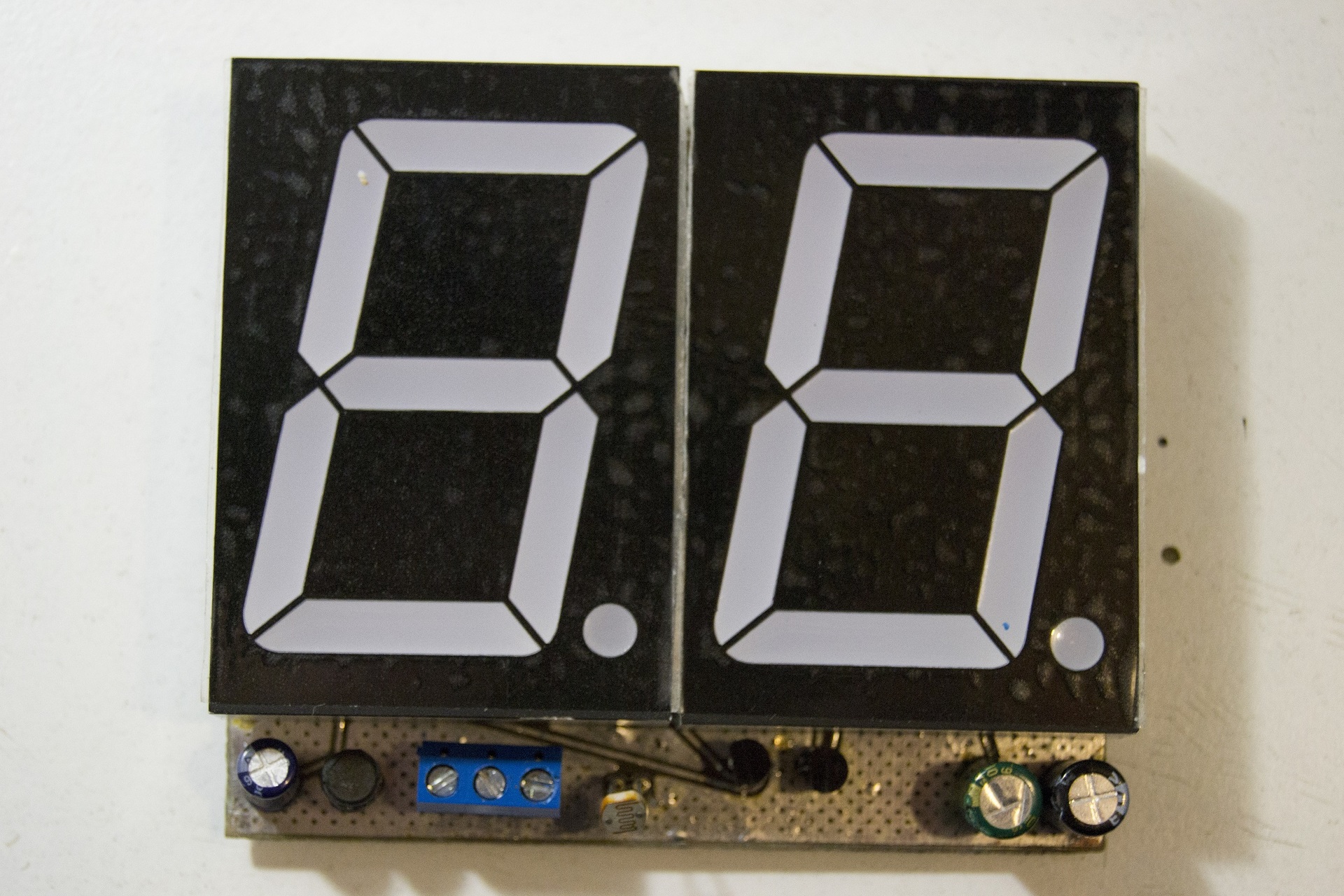HUD speedometer - from idea to result
Hello!
I have not written anything for a long time, now it is more a news resource, and not a practical one. I'll try to correct the situation. I'll tell you about the development of a HUD-speedometer. Although not a laser projection , it is accessible and compact.
Introduction
It started with the fact that I got into the hands of the big 3.3 "seven-segment indicators. I ordered them for watches that were not born. It was necessary to have 4 pieces, in lot 5, the Chinese put six. After evaluating the size, brightness and reflection from the windshield, I decided - here it is. Due to the size, the split image is not visible, and the brightness allows you to use it even in direct sun.I agree that the Chinese have beautiful ready-made pieces that are quite inexpensive (all prices at the time of this writing) are from 1800r. (close eyes on unsporting such a decision):
1. It is necessary to glue the film on the glass - though it is transparent, but all are overlaps review, but I do not like being on the glass that is preventing Hardly sat, pushed a chair - and the film should be, and even glue Well.. with film almost nothing is visible on a sunny day.
2. You can not glue the film, then tsiferki (they are quite small) are split, and nothing is visible in the sun.
For the seed, the result is without film anywhere in the glass and even during the day:

I promise a lot of pictures under the cut, mediocre video, code and text - all in the best traditions.
Theory
The idea is simple - for a fixed period of time, we count the number of pulses from the speed sensor. As a simple and affordable CPU, ATMega8.
The first difficulty turned out to be in agreement with the MK 5 V and the 7.5 V indicators. Fantasy drew a circuit from a pack of transistors and resistors (7 elements with dynamic indication). Of all Google, only one article about the replacement of indicators in the clock helped me, sorry I lost her address. Taking this opportunity, I convey my gratitude to the author for the idea of using TD62783 (from 5 pieces in a lot). Actually, this is a seven-segment indicator driver, inside a transistor assembly.
Next, a DC / DC converter. I made it on MC34063, I have a lot of them, I stock them. I counted on a calculator, checked it with a tester - 7.5 V. In the field tests it was not enough, there was not enough brightness, it increased to 10 V.
The brightness is adjusted based on the readings of the light sensor, which is the usual Chinese photoresistor.
As a result, the scheme turned out to be this:

Practice
Printed circuit board I parted TopoR . I took advantage of auto-placement, although I fixed most of the elements manually. But progress must work for me, not only for progress. It turned out beauty:


With the width of the case U4 overshot, I had to finish the tracks and not solder the 11th leg.
How it looks in real life:



The next nezhdanchik crept in the software (I will not tell you how I forgot to mirror the 2 and 5, 4 - there is nothing to be proud of). The more difficult was the problem: the counter had the necessary number of pulses for too long. For example, at 60 km / h, counting 60 pulses from the speed sensor took more than a second. This rare update of the testimony did not suit me.
It was necessary to multiply each measurement floor by 2.
Linear change in brightness compared with illumination did not fit: when it was slightly darker - the brightness was insufficient, when it was almost dark - the brightness was too. Launched Excel, built a graph for different mathematical functions. In the end, I chose the square.

Bascom code:
At the end of the 135 - correction factor, selected it for each machine individually (135 is for Logan, for Solaris was less - everyone has different speed sensors).
Promised video. Sorry for the quality, filmed on a piece of blue tape with one hand, ruled with the other:
Indicators do not light when the speed is less than 3 km / h. If the speed is greater than 99, it displays without the first character.
Budget:
ATMega8 - 200r for 5 pieces - 40p
Indicators - 825r for 10 pieces - 165r
TD62783 - 250r for 5 pieces - 50r
I had the rest of the distribution, but on the whole it is clear that you can keep within 500r.
More to tell and nothing. It turned out a big beautiful counter. Tested on Solaris. The focus failed, the focus was not a speed sensor. Slightly finish the program for working with OBD2 via ELM327.
Folder with the project on Yandex.Disk
Thank you all for your attention!
I have not written anything for a long time, now it is more a news resource, and not a practical one. I'll try to correct the situation. I'll tell you about the development of a HUD-speedometer. Although not a laser projection , it is accessible and compact.
Introduction
It started with the fact that I got into the hands of the big 3.3 "seven-segment indicators. I ordered them for watches that were not born. It was necessary to have 4 pieces, in lot 5, the Chinese put six. After evaluating the size, brightness and reflection from the windshield, I decided - here it is. Due to the size, the split image is not visible, and the brightness allows you to use it even in direct sun.I agree that the Chinese have beautiful ready-made pieces that are quite inexpensive (all prices at the time of this writing) are from 1800r. (close eyes on unsporting such a decision):
1. It is necessary to glue the film on the glass - though it is transparent, but all are overlaps review, but I do not like being on the glass that is preventing Hardly sat, pushed a chair - and the film should be, and even glue Well.. with film almost nothing is visible on a sunny day.
2. You can not glue the film, then tsiferki (they are quite small) are split, and nothing is visible in the sun.
For the seed, the result is without film anywhere in the glass and even during the day:

I promise a lot of pictures under the cut, mediocre video, code and text - all in the best traditions.
Theory
The idea is simple - for a fixed period of time, we count the number of pulses from the speed sensor. As a simple and affordable CPU, ATMega8.
The first difficulty turned out to be in agreement with the MK 5 V and the 7.5 V indicators. Fantasy drew a circuit from a pack of transistors and resistors (7 elements with dynamic indication). Of all Google, only one article about the replacement of indicators in the clock helped me, sorry I lost her address. Taking this opportunity, I convey my gratitude to the author for the idea of using TD62783 (from 5 pieces in a lot). Actually, this is a seven-segment indicator driver, inside a transistor assembly.
Next, a DC / DC converter. I made it on MC34063, I have a lot of them, I stock them. I counted on a calculator, checked it with a tester - 7.5 V. In the field tests it was not enough, there was not enough brightness, it increased to 10 V.
The brightness is adjusted based on the readings of the light sensor, which is the usual Chinese photoresistor.
As a result, the scheme turned out to be this:

Practice
Printed circuit board I parted TopoR . I took advantage of auto-placement, although I fixed most of the elements manually. But progress must work for me, not only for progress. It turned out beauty:


With the width of the case U4 overshot, I had to finish the tracks and not solder the 11th leg.
How it looks in real life:



The next nezhdanchik crept in the software (I will not tell you how I forgot to mirror the 2 and 5, 4 - there is nothing to be proud of). The more difficult was the problem: the counter had the necessary number of pulses for too long. For example, at 60 km / h, counting 60 pulses from the speed sensor took more than a second. This rare update of the testimony did not suit me.
It was necessary to multiply each measurement floor by 2.
Linear change in brightness compared with illumination did not fit: when it was slightly darker - the brightness was insufficient, when it was almost dark - the brightness was too. Launched Excel, built a graph for different mathematical functions. In the end, I chose the square.

Bascom code:
Hidden text
'HUD-speedometer
'17/01/2016
'21/01/2016
'v1.1
$regfile = "m8adef.dat"
$crystal = 4000000
$hwstack = 40
$swstack = 16
$framesize = 32
Config Portb = Output
Config Portc = Output
Config Portd = Output
Config Portd.4 = Input
Portd.4 = 1
Config Timer0 = Counter , Edge = Falling
Config Timer1 = Pwm , Pwm = 8 , Compare_a_pwm = Clear_up , Compare_b_pwm = Clear_up , Prescale = 8
Config Timer2 = Timer , Prescale = 1024
On Timer2 Mytimer2
Enable Interrupts
Enable Timer2
Config Adc = Single , Prescaler = Auto , Reference = Internal
Start Adc
Dim I As Byte 'счётчик в основной цикл
Dim N As Byte 'счётчик в таймер
Dim Pwm_value As Integer 'яркость
Dim Speed As Integer , Speed_half As Integer , First_symbol As Integer , Second_symbol As Integer
Dim A As Integer 'разность Speed и Speed_half
Dim R1 As Word
Declare Sub Digit_indication(digit As Integer) 'вывод цифры
Const P = 500
Const T = 5000 'время горения одного индикатора
Const T1 = 1000 'время паузы для срабатывания PWM
Pwm_value = 5
Tcnt0 = 0 'счётчик
Do
Incr I
If I = 25 Then 'чтоб не перегружать МК
R1 = Getadc(7)
R1 = Sqr(r1) 'делаем гиперболу
R1 = R1 * 8
If R1 < 250 Then
Pwm_value = 250 - R1
Else
Pwm_value = 3 'минимальная яркость
End If
I = 0
End If
Gosub Indication
Loop
Indication:
If Speed < 3 Then 'если скорость 0 - не горит, 3 - защита от помех
Pwm_value = 0
End If
While Speed > 99 'т.к. всего 2 знака
Speed = Speed - 100
Wend
First_symbol = Speed / 10 'записали отдельно
Second_symbol = First_symbol * 10 'десятки
Second_symbol = Speed - Second_symbol 'отдельно еденицы
Pwm1b = 0
Pwm1a = 0
Waitus T1 'без паузы подмигивает
Call Digit_indication(first_symbol) 'и выводим цифры
Pwm1b = Pwm_value
Waitus T
Pwm1b = 0
Pwm1a = 0
Waitus T1 'без паузы подмигивает
Call Digit_indication(second_symbol)
Pwm1a = Pwm_value
Waitus T
Return
Sub Digit_indication(digit As Integer)
Select Case Digit
Case 0:
Portd.0 = 0
Portc.0 = 1
Portc.1 = 1
Portc.2 = 1
Portc.3 = 1
Portc.4 = 1
Portc.5 = 1
Case 1:
Portd.0 = 0
Portc.0 = 1
Portc.1 = 0
Portc.2 = 0
Portc.3 = 0
Portc.4 = 0
Portc.5 = 1
Case 2:
Portd.0 = 1
Portc.0 = 0
Portc.1 = 1
Portc.2 = 1
Portc.3 = 0
Portc.4 = 1
Portc.5 = 1
Case 3:
Portd.0 = 1
Portc.0 = 1
Portc.1 = 1
Portc.2 = 0
Portc.3 = 0
Portc.4 = 1
Portc.5 = 1
Case 4:
Portd.0 = 1
Portc.0 = 1
Portc.1 = 0
Portc.2 = 0
Portc.3 = 1
Portc.4 = 0
Portc.5 = 1
Case 5:
Portd.0 = 1
Portc.0 = 1
Portc.1 = 1
Portc.2 = 0
Portc.3 = 1
Portc.4 = 1
Portc.5 = 0
Case 6:
Portd.0 = 1
Portc.0 = 1
Portc.1 = 1
Portc.2 = 1
Portc.3 = 1
Portc.4 = 1
Portc.5 = 0
Case 7:
Portd.0 = 0
Portc.0 = 1
Portc.1 = 0
Portc.2 = 0
Portc.3 = 0
Portc.4 = 1
Portc.5 = 1
Case 8:
Portd.0 = 1
Portc.0 = 1
Portc.1 = 1
Portc.2 = 1
Portc.3 = 1
Portc.4 = 1
Portc.5 = 1
Case 9:
Portd.0 = 1
Portc.0 = 1
Portc.1 = 1
Portc.2 = 0
Portc.3 = 1
Portc.4 = 1
Portc.5 = 1
End Select
End Sub
Mytimer2:
Incr N
If N = 26 Then
N = 0
Speed = Tcnt0 'Speed = количество импульсов с датчика
Tcnt0 = 0 'сброс счётчика импульсов
End If
If N = 13 Then 'т.к. количество импульсов набегает слишком долго (редко меняются показания)
Speed_half = Tcnt0 * 2 'добавим удвоение
A = Speed - Speed_half
A = A And &B0111111111111111 'модуль
If A > 2 Then
Speed = Speed_half
End If
End If
Timer2 = 135 'корректировочка 135 логан
Return
At the end of the 135 - correction factor, selected it for each machine individually (135 is for Logan, for Solaris was less - everyone has different speed sensors).
Promised video. Sorry for the quality, filmed on a piece of blue tape with one hand, ruled with the other:
Indicators do not light when the speed is less than 3 km / h. If the speed is greater than 99, it displays without the first character.
Budget:
ATMega8 - 200r for 5 pieces - 40p
Indicators - 825r for 10 pieces - 165r
TD62783 - 250r for 5 pieces - 50r
I had the rest of the distribution, but on the whole it is clear that you can keep within 500r.
More to tell and nothing. It turned out a big beautiful counter. Tested on Solaris. The focus failed, the focus was not a speed sensor. Slightly finish the program for working with OBD2 via ELM327.
Folder with the project on Yandex.Disk
Thank you all for your attention!
